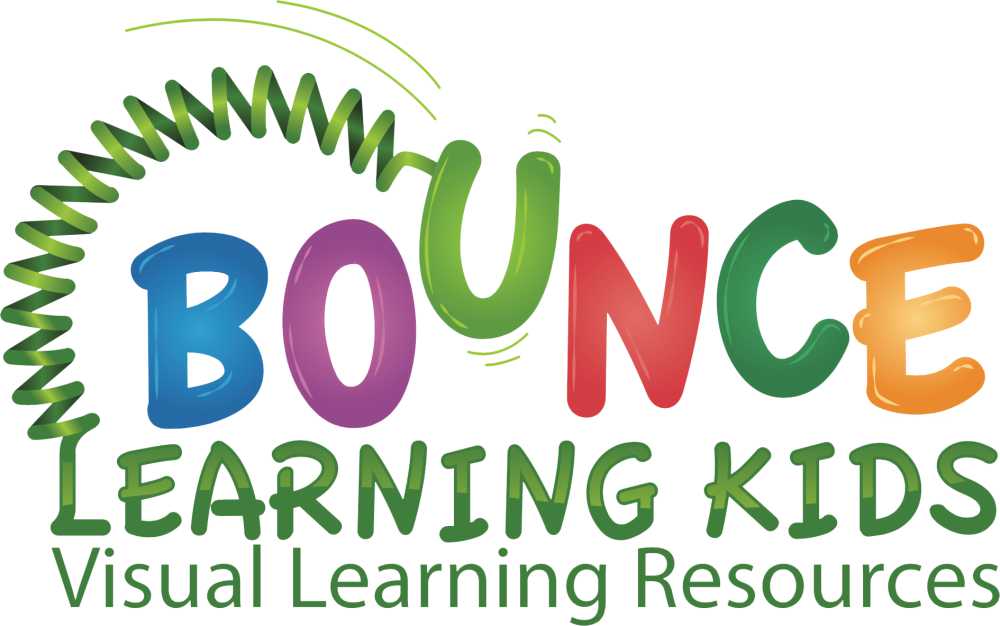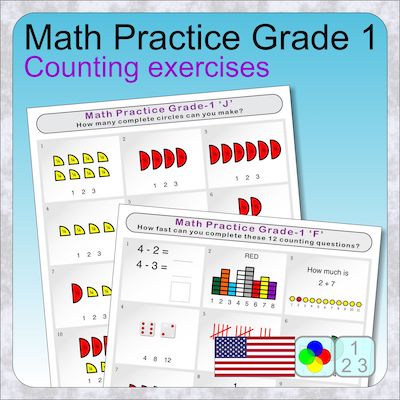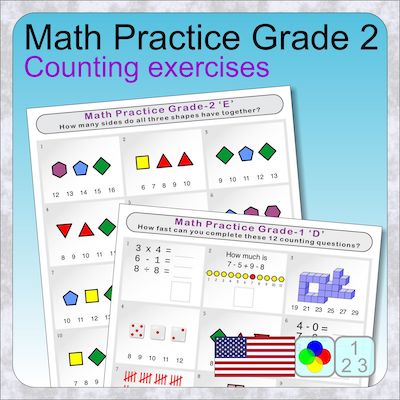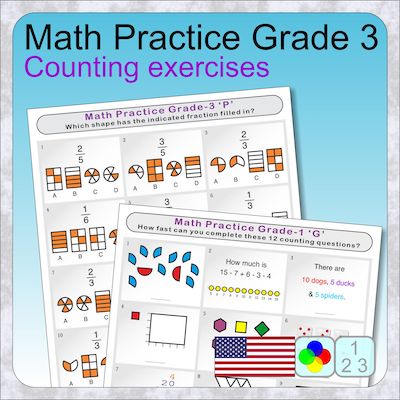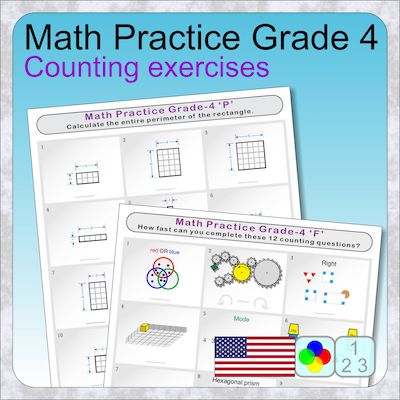Math practice counting exercises
4 series of worksheets that provide countless ways for grade1-4 students to perform counting practice exercises to reinforce basic mathematical concepts.
Four difficulty levels
There are 4 difficulty levels in all. Each level is slightly more challenging than the previous. The same exercises feature in each the first 3 levels (level 4 has a different set of more challenging exercises), but there are different tactics to make the exercises more challenging as you progress through the levels. This might include using higher numbers, more multiples or the removal of the multi-choice options, etc.
Four currencies
Each product has 4 currency versions to choose from, since some of the exercises involve the counting of coins. Choose the most appropriate currency version for your region:
- USA
- Canada
- Austrlia
- UK
- EU
See also the BOOM Learning versions of the Math Fun learn to count range.
Grade/Year 1
The following types of exercises are featured in this level 1 version. Each worksheet has 12 practice questions. The following types of questions are featured:
- Count the sides on the shapes.
- Count the number of times the lines cross.
- Count the number of semi-circles you can see.
- Count the number of triangles there are (including the overlapping ones).
- Add the pairs of numbers, and then add the two answers together.
- Count the number of blocks in the indicated column.
- Add up all the numbers in the sentence.
- Count the number of squares (including the overlapping ones).
- Work out the next number in the sequence.
- Work out how many complete circles you can make with the available pieces.
- Count the tally marks.
- How many cubes can you see?
- Add up the numbers on the two dice.
- Find the number on the number line.
- Count the number of equally sized parts of the shape.
- Work out which shape has the indicated fraction colored in.
- Add up the total number of legs.
- Subtract the numbers from each other, then add the two answers together.
- Count the number of equally sized small red blocks.
- Count the money.
Level-2
The following types of exercises are featured in this level 2 version. Each worksheet has 12 practice questions. The following types of questions are featured:
- Count the colored dots.
- Add up all the numbers in the sentence.
- Count the number of blocks in the tallest & shortest columns.
- Count the number of times the lines cross.
- Add up the number of sides on all 3 shapes.
- Solve the 3 sums, then add all 3 answers together.
- Count the number of complete circles you can make using the available parts.
- Count the number of squares (including the overlapping iones).
- Count the number of semi-circles there are.
- Count the number of triangles (including the overlapping iones).
- Count the money.
- Find the number on the number line.
- Count the number of equally sized colored blocks.
- Count the tally marks.
- Work out which shape has the indicated fraction colored in.
- Solve the 3 subtraction sums, then add the 3 answers together.
- Count the number of cubes you can see.
- Read the sentences and work out how many things remain.
- Count the number of dots on all 3 dice.
- Count the number of equally sized parts of the shape.
Level-3
The following types of exercises are featured in this level 3 version. Each worksheet has 12 practice questions. The following types of questions are featured:
- Count the number of semi-circles you can see.
- Count the squares (including the overlapping ones).
- Count the number of sides on all 6 shapes.
- Count the triangles including the overlapping ones).
- Which side of the balance beam is heaviest and what will the beam do?
- Read the sentence and work out the sum.
- Count the number of indicated dots.
- Count the total number of legs & wings.
- Work out how many complete circles you can make with the available parts.
- Count the number of times the lines cross.
- Count the tally marks.
- Find the number on the number line.
- Read the sentences and work out how many things remain.
- Count the number of equally sized parts of the shape.
- Count the money.
- Work out which shape has the indicated fraction colored in.
- Count the number of edges the shape has.
- Work out how many red squares fit into the shape.
- Add up all 6 numbers.
- Count the number of dots on all 6 dice.
Level-4
The following types of exercises are featured in this level 4 version. Each worksheet has 12 practice questions. The following types of questions are featured:
- Work out which 2D shpae folds to crate the 3D shape.
- Work out what percentage of the shape is colored in.
- Work our which way the green cog will turn when the yellow cog is turns as indicated.
- Work out how big the indicated andgle is.
- Count the number of people.
- Work out which number or operator completes the sum.
- Work out what the time was or will be.
- Work out how many of the yellow cubes will it take to completely fill the 3D space.
- Venn diagrams: Work out how many dots are in the indicated circle(s)
- Forces: Work out which side exerts the most force and what the balance beam will do.
- Rotation symmetry: Work out which yellow shape is a rotation of the blue shape.
- Money: Work out how much change you will have.
- Angles: Add up all the colored angles.
- Work out the sum.
- Work out how many of the indicated angles are colored in.
- Work out the total perimeter length of each rectangle.
- Mirror symmetry: Work out which green shape is a mirror image of the red shape.
- Work out which of the available numbers you need to add together to get the target number.
- Work out how many more of the bottom category there are compared to the top category.
- Work out the indicated average.
